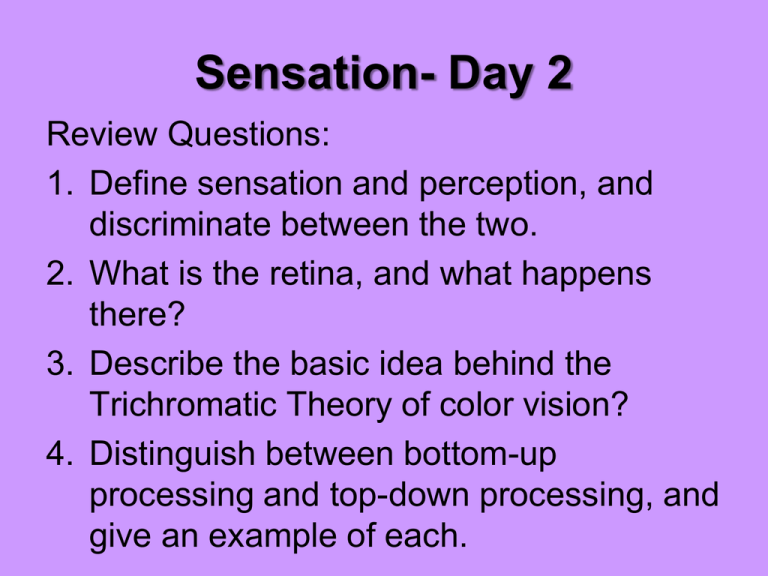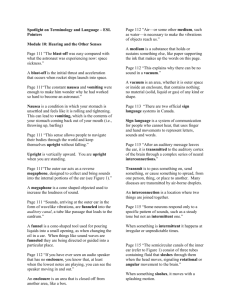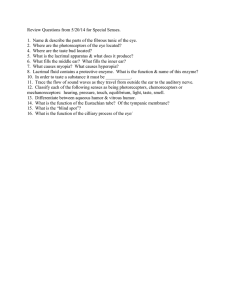Sensation- Day 2
advertisement

Sensation- Day 2 Review Questions: 1. Define sensation and perception, and discriminate between the two. 2. What is the retina, and what happens there? 3. Describe the basic idea behind the Trichromatic Theory of color vision? 4. Distinguish between bottom-up processing and top-down processing, and give an example of each. Hearing Aka: Audition Why do we have two ears? Sound • Sound, like light, comes in waves • Sound is vibration • Features of sound include: – Pitch – Hertz – Decibels Pitch • A sound’s highness or lowness • Dependent on the frequency of the sound wave • Is measured as hertz (Hz) Hertz (Hz) • A measure of the number of sound wave peaks per second; measures “frequency” • Determines the pitch of the sound • Human hearing goes from 20 Hz to 20,000 Hz Decibel (dB) • A measure of the height of the sound wave • Determines the loudness of the sound • Sometimes called amplitude Amplitude is how loud the sound is. The higher the crest of the wave is the louder the sound is. It is measured in decibels. Hearing: The Structure of the Auditory System Parts of the Ear – Sound Waves Auditory Canal • The opening through which sound waves travel as they move into the ear for processing • Ends at the tympanic membrane (eardrum) Parts of the Ear – Auditory Canal Tympanic Membrane (eardrum) • The tissue barrier that transfers sound vibration from the air to the tiny bones of the middle ear • Can be damaged by objects in the ear or exceptionally loud noises Parts of the Ear – Tympanic Membrane Ossicles • Three tiny bones that transfer sound waves from the eardrum to the cochlea • Hammer, anvil and stirrup Parts of the Ear - Occicles Cochlea • A hearing organ where sound waves are changed into neural impulses • The major organ of hearing • Filled with fluid; a snail shaped body tube Cochlear Implant Parts of the Ear - Cochlea Hair Cells • The receptor cells for hearing in the cochlea that change sound vibrations into neural impulses • Similar to the rods and cones within the eye Parts of the Ear - Hair Cells Auditory Nerve • The nerve that carries sound information from the ears to the temporal lobes of the brain Parts of the Ear – Auditory Nerve Semicircular Canals • Organs in the inner ear used in sensing body orientation and balance (vestibular sense) • Relies on fluid in the canals • Spinning in circles disrupts the fluid. Parts of the Ear – Semicircular Canals Divisions of the Ear • Ear’s structure can be divided into: – The outer ear – The middle ear – The inner ear Divisions of the Ear Divisions of the Ear Divisions of the Ear How do we perceive differences in pitch? There are two theories…….. Place Theory • We hear different pitches because different sound waves trigger activity at different places along the cochlea’s basilar membrane. Frequency Theory • We sense pitch by the basilar membrane vibrating at the same rate as the sound. • But this theory has trouble explaining high pitch sounds because our hairs cannot vibrate at certain speeds. Hearing loss • Conduction Hearing Loss: caused by damage to mechanical system of ear. •Sensorinueral hearing loss: caused by damage to cochlea’s receptor cells or to auditory nerves. Cochlea Implant Smell and Taste Why do we study smell and taste together? • SENSORY INTERACTION: the principle that one sense may influence another. Taste • Taste is a chemical sense. • Receptor cells are located primarily on the tongue and in the mouth. • Four different tastes: – Salty, sweet, sour and bitter • Damaged taste receptor cells are replaced within a few days. How do we taste? •Taste (and smell) are chemical senses. What is the central muscle involved in taste? Taste Buds Map out the tongue Papillae • Those bumps on our tongue are called Papillae. • Papillae help grip food while your teeth are chewing. • They also have another special job they contain your taste buds TASTE http://bookworm.com.sg/e-book-preview/e-science-10-senses-pg05-pic04b.gif PTC Strips Supertasters • People with an abundance of taste receptors • Approximately 25% of the population Nontasters • People with a minimum of taste receptors • Taste with less intensity than the rest of the population • Approximately 25% of the population But what about smell? Can our sense of smell be biologically based? Smell • Smell is a chemical sense. • Olfactory cells in the upper nasal passages detect molecules in the air. • Taste and smell interact to produce flavor. Olfactory Cells • The chemical receptor cells for smell • Located in the nasal passages Gender related odors • Can you smell the difference between? So can we smell the difference? • Well….yes and no. Pheromones •Chemical messengers that are picked up through our sense of smell. •Founded in the early 1930’s by studying silkworms. •Jury is still out on whether they exist in humans. Body Senses Kinesthetic Sense • Tells us where our body parts are. • Receptors located in our muscles and joints. Kinesthetic Sense • The system for sensing the position and movement of individual body parts • Relies on receptor cells from the muscles and joints • One’s leg “falling asleep” is a disruption of the kinesthetic sense Vestibular Sense • Tells us where our body is oriented in space. • Our sense of balance. • Located in our semicircular canals in our ears. Vestibular Sense • The system for sensing body orientation and balance • Relies on fluid in the semicircular canals of the inner ear • Spinning in circles disrupts the fluid. Parallel Processing • The processing of several aspects of a problem simultaneously. Color Motion Form Depth Feature Detection The concept that specific nerve cells in the brain respond to specific features of the stimulus, such as shape angle or movement. The End


